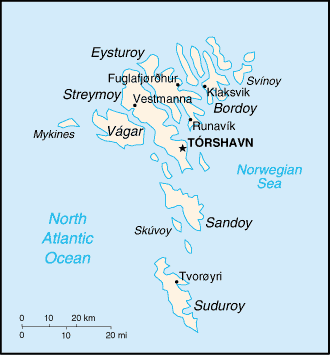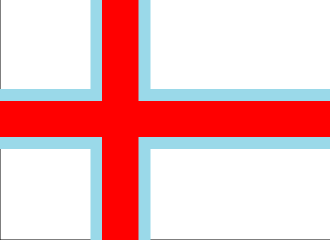
|
Faroe Islands
Background:
The population of the Faroe Islands is largely descended from
Viking settlers who arrived in the 9th century. The islands have been connected
politically to Denmark since the 14th century. A high degree of self-government
was attained in 1948.
Location:
Northern Europe, island group between the Norwegian Sea and the North
Atlantic Ocean, about one-half of the way from Iceland to Norway.
Geographic coordinates: 62 00 N, 7 00 W.
Map references: Europe.
Area: Total: 1,399 sq km. land: 1,399 sq km. water: 0 sq km (some lakes and
streams).
Area - comparative: Eight times the size of Washington, DC.
Coastline: 1,117 km.
Climate and Terrain:
Mild winters, cool summers; usually overcast; foggy, windy.
Rugged, rocky, some low peaks; cliffs along most of coast.
Elevation extremes: Lowest point: Atlantic Ocean 0 m. Highest point:
Slaettaratindur 882 m.
Natural resources: Fish, whales, hydropower.
Land use: Arable land: 6% permanent crops: 0% permanent pastures: 0%
forests and woodland: 0% other: 94% (1996).
Irrigated land: 0 sq km. Geography - note: Archipelago of 17 inhabited islands
and one uninhabited
island, and a few uninhabited islets; strategically located along important sea
lanes in northeastern Atlantic; precipitous terrain limits habitation to small
coastal lowlands.
People:
Population: 45,661 (July 2001 est.).
Ethnic groups: Scandinavian.
Religions: Evangelical Lutheran.
Languages: Faroese (derived from Old Norse), Danish.
Government:
Capital: Torshavn.
Independence: none (part of the Kingdom of Denmark; self-governing overseas
administrative division of Denmark).
Economy overview:
The Faroese economy has had a strong performance since
1994, mostly as a result of increasing fish landings and high and stable export
prices. Unemployment is falling and there are signs of labor shortages in
several sectors. Labor force: 24,250 (October 2000).
Labor force - by occupation: Fishing, fish processing, and manufacturing 33%,
construction and private services 33%, public services 34%.
Industries: Fishing, fish processing, shipbuilding, construction, handicrafts.
Agriculture - products: Milk, potatoes, vegetables; sheep; salmon, other fish.
Statistics:
Telephones - main lines in use: 24,851.
Telephones - mobile cellular: 10,761.
Radio broadcast stations: AM 1, FM 13.
Radios: 26,000 (1997).
Television broadcast stations: 3.
Televisions: 15,000.
Internet users: 3,000.
Railways: 0 km.
Highways: Total: 463 km paved: 454 km unpaved: 9 km.
Airports - with paved runways: Total: 1.
Return to Visiting Locations
|

